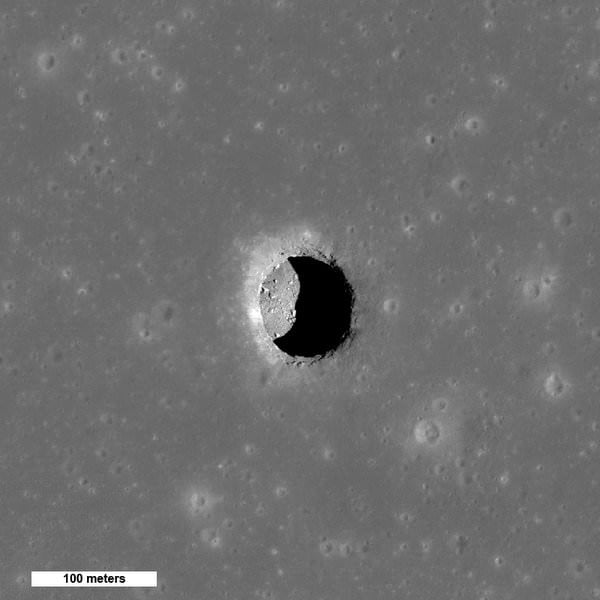As promised, the Lunar Reconnaissance Orbiter is taking more detailed looks at the lunar pits, or lava tubes that have been discovered by LRO and the Kaguya spacecraft. These are deep holes on the moon that could open into vast underground tunnels, and could serve as a safe, radiation shielding habitats for future human lunar explorers. Plus, they are just plain intriguing! This image of a pit found in the Sea of Tranquility (Mare Tranquillitatis) was taken as the Sun was almost straight overhead, illuminating the region. By comparing this image with previous images that have different lighting, scientists can estimate the depth of the pit. They believe it to be over 100 meters!
See more "in-depth" look at more of the caves on the Moon, below:
[caption id="attachment_73661" align="aligncenter" width="600"]
Two views of Mare Ingenii pit Credit: NASA/GSFC/Arizona State University.[/caption]
These two images show a pit in Mare Ingenii, which reveal different portions of the floor as the Sun crosses from west to east. Again, by measuring the shadows in different lighting, the Sea of Cleverness pit appears to be about 70 meters deep and about 120 meters wide.
These long, winding lava tubes are like structures we have on Earth. They are created when the top of a stream of molten rock solidifies and the lava inside drains away, leaving a hollow tube of rock. There have been hints that the Moon had lava tubes based on observations of long, winding depressions carved into the lunar surface by the flow of lava, called sinuous rilles.
If a human geologist could ever climb down inside these tubes on the Moon, we could learn so much about the Moon's history, and sort of travel back in time by studying the different layers on the Moon, just like we do on Earth.
[caption id="attachment_73662" align="aligncenter" width="600"]
Three views of the Marius Hills pit. Credit: NASA/GSFC/Arizona State University.
[/caption]
LROC has now imaged the Marius Hills pit three times, each time with very different lighting. The center view has an incidence angle of 25° that illuminates about three-quarters of the floor. The Marius pit is about 34 meters deep and 65 by 90 meters wide.
Read more about the
Ingenii
,
Tranquillitatis
, and
Marius
pits at the LROC website, and you can search the nearby area for clues in the
full LROC NAC frame
that may help determine if an extended lava tube system still exists beneath the surface.
Source:
LROC website
 Universe Today
Universe Today
